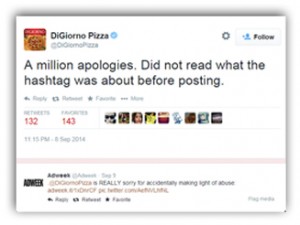I love watching trending topics on Twitter. I find “in the moment” dialogue of world events fascinating. Though I am not a regular tweeter, you can bet I’m reading when something big is happening. A few of my favorite trending topics have included when Felix Baumgartner jumped from 24 miles above earth, when Ussain Bolt broke the 200M record at the 2012 Olympics, when Beyonce performed during half-time at the XLVII Super Bowl.

It was during that 2013 half-time show – or rather, during the 30-minute suspension of play caused by a power failure immediately following Beyonce’s electrifying appearance – that I began to really study total Twitter touchdowns and Twitter epic fails.
When I saw a tweet from Oreo pop up on my iPhone during that looonnnggg suspension of play, I thought it was sheer brilliance. The 21-character Tweet, “Power Out? No problem” was accompanied by an elegant, simple graphic reading, “You can still dunk in the dark.” It was a fast, smart, hyper-relevant message to, arguably, the largest global audience of its kind, most years.
Though Oreo didn’t hashtag their post to the #SuperBowl, many retweeters (including this one) did. Before the fans in the nosebleed seats in New Orleans had run down their batteries using the flashlight function on their smart phones, the Oreo tweet was worldwide. If I’d had a bag of the cookies in my house that night, you can bet my family would have torn into them in celebration.
I added the #SuperBowl tag when I retweeted Oreo’s post so my little message would get caught up in the stream/river/rushing tsunami of Super Bowl tweets. It was my way of sharing in the global experience of our nation’s biggest annual sports event.
You added #icebucketchallenge to your recent Tweet or Facebook page for the same reason, right? To take advantage of the trend, to elevate your post, and to bring awareness to ALS. A rising tide lifts all boats, right?
Well, just as sub-prime mortgages and the asymmetric haircut have proved in the past, not all trends are created equal – and not all hashtags lend themselves to selling cookies … or pizza. DiGiorno Pizza – known for riding trends on Twitter – slipped hard earlier last week when they used the #WhyIStayed hashtag in a tweet about pizza. Somehow, a now very regretful social media manager tagged an official company tweet with #WhyIStayed – a tag created by a social worker and advocate for victims of domestic abuse in response to the NFL / Ray Rice travesty.
DiGiorno recognized the error very quickly and pulled the tweet, then spent considerable time responding with apology and honesty for 1) not knowing what the hashtag represented and 2) inadvertently making light of domestic abuse. The company’s unpolished, earnest responses have helped the brand regain some lost ground, but the event remains a bit of black eye. And just like Pizza Hut and United Airlines gaffes before them, it will serve as a case study in college communications courses and crisis communication seminars for a long, long time.
While most people can respect that accidents happen, social media managers must always remember: we are corporate communications professionals, even if we don’t follow AP Style and basic grammar and spelling conventions. When we stand on a company’s brand and speak to the entire globe through social media, we need to make darn sure we know what we’re talking about.